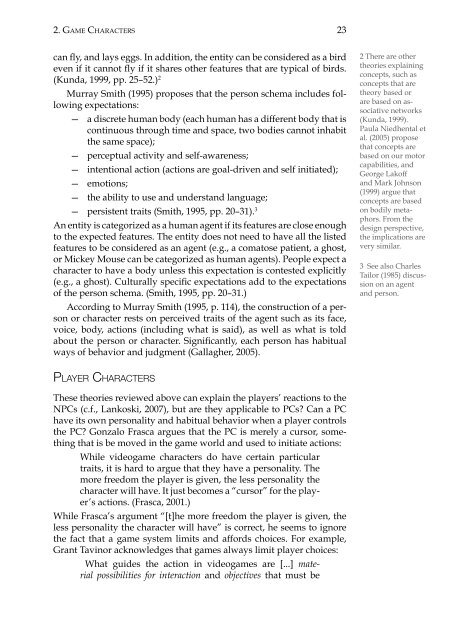Character Driven Game Design
Character Driven Game Design
Character Driven Game Design
You also want an ePaper? Increase the reach of your titles
YUMPU automatically turns print PDFs into web optimized ePapers that Google loves.
2. <strong>Game</strong> <strong>Character</strong>s 23<br />
can fly, and lays eggs. In addition, the entity can be considered as a bird<br />
even if it cannot fly if it shares other features that are typical of birds.<br />
(Kunda, 1999, pp. 25–52.) 2<br />
Murray Smith (1995) proposes that the person schema includes following<br />
expectations:<br />
——<br />
a discrete human body (each human has a different body that is<br />
continuous through time and space, two bodies cannot inhabit<br />
the same space);<br />
——<br />
perceptual activity and self-awareness;<br />
——<br />
intentional action (actions are goal-driven and self initiated);<br />
——<br />
emotions;<br />
——<br />
the ability to use and understand language;<br />
——<br />
persistent traits (Smith, 1995, pp. 20–31). 3<br />
An entity is categorized as a human agent if its features are close enough<br />
to the expected features. The entity does not need to have all the listed<br />
features to be considered as an agent (e.g., a comatose patient, a ghost,<br />
or Mickey Mouse can be categorized as human agents). People expect a<br />
character to have a body unless this expectation is contested explicitly<br />
(e.g., a ghost). Culturally specific expectations add to the expectations<br />
of the person schema. (Smith, 1995, pp. 20–31.)<br />
According to Murray Smith (1995, p. 114), the construction of a person<br />
or character rests on perceived traits of the agent such as its face,<br />
voice, body, actions (including what is said), as well as what is told<br />
about the person or character. Significantly, each person has habitual<br />
ways of behavior and judgment (Gallagher, 2005).<br />
2 There are other<br />
theories explaining<br />
concepts, such as<br />
concepts that are<br />
theory based or<br />
are based on associative<br />
networks<br />
(Kunda, 1999).<br />
Paula Niedhental et<br />
al. (2005) propose<br />
that concepts are<br />
based on our motor<br />
capabilities, and<br />
George Lakoff<br />
and Mark Johnson<br />
(1999) argue that<br />
concepts are based<br />
on bodily metaphors.<br />
From the<br />
design perspective,<br />
the implications are<br />
very similar.<br />
3 See also Charles<br />
Tailor (1985) discussion<br />
on an agent<br />
and person.<br />
Player <strong>Character</strong>s<br />
These theories reviewed above can explain the players’ reactions to the<br />
NPCs (c.f., Lankoski, 2007), but are they applicable to PCs? Can a PC<br />
have its own personality and habitual behavior when a player controls<br />
the PC? Gonzalo Frasca argues that the PC is merely a cursor, something<br />
that is be moved in the game world and used to initiate actions:<br />
While videogame characters do have certain particular<br />
traits, it is hard to argue that they have a personality. The<br />
more freedom the player is given, the less personality the<br />
character will have. It just becomes a “cursor” for the player’s<br />
actions. (Frasca, 2001.)<br />
While Frasca’s argument “[t]he more freedom the player is given, the<br />
less personality the character will have” is correct, he seems to ignore<br />
the fact that a game system limits and affords choices. For example,<br />
Grant Tavinor acknowledges that games always limit player choices:<br />
What guides the action in videogames are [...] material<br />
possibilities for interaction and objectives that must be
















